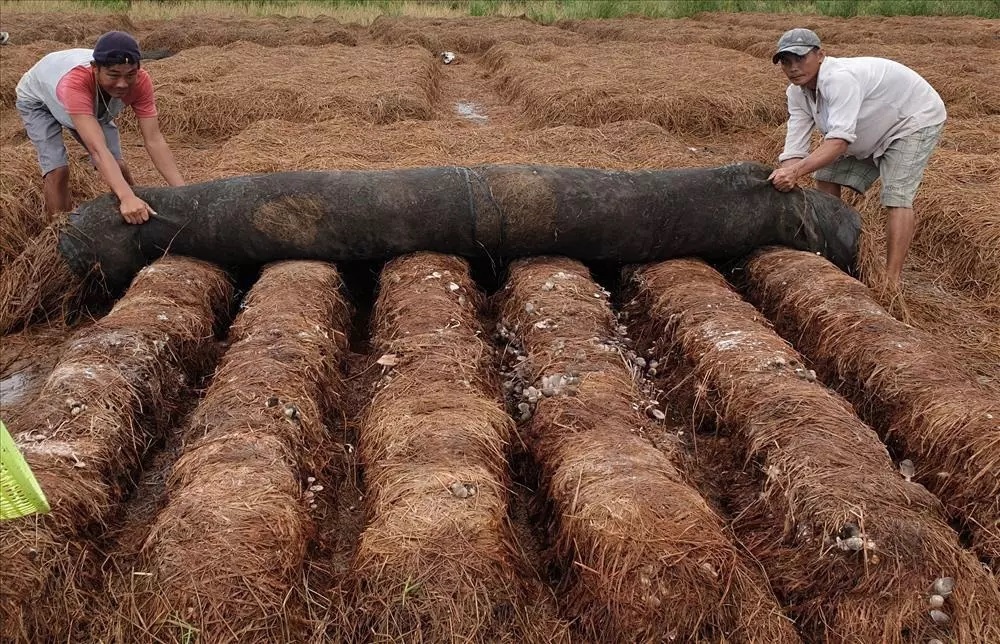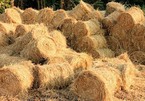In the northern mountainous province of Son La, corncobs are no longer waste but have become "black gold". Millions of tons of corncobs have been processed into a kind of coal that generates high heat energy and produces low emissions exported to many countries.
In Ho Chi Minh City, Trai Viet Company collects all kinds of agricultural by-products such as cassava residue, molasses, bagasse and corn cobs to process into tablet-formed animal feed for domestic consumption and export.
Former Minister of Agriculture and Rural Development Nguyen Xuan Cuong introduced mushroom-growing models in the provinces of Vinh Phuc and Lam Dong, which used bagasse to cultivate mushrooms, earning very high profits. According to Cuong, for this model, bagasse is more valuable than sugarcane juice. He advised Vietnamese businesses to go to Japan to learn more about this technology.
Huge resources
 |
|
|
Tong Xuan Chinh, Deputy Director of the Department of Livestock Production (Ministry of Agriculture and Rural Development), said that in 2020 Vietnam produced a large amount of food and foodstuff products to meet the needs of over 97 million Vietnamese and for export, earning over 41 billion USD. In the production, preservation, preliminary processing and processing of agricultural products, the proportion of agricultural by-products was up to 156 million tons.
A report of the Working Group 970 (Ministry of Agriculture and Rural Development) indicated that by-products in the cultivation sector amounted to 88.9 million tons, accounting for 56.7% of Vietnam's agricultural by-products with three different sources. In particular, the post-harvest by-products mainly come from annual crops, firewood from perennial plants and from processing nuts, fruits, and vegetables.
In 2020, post-harvest by-products from cultivation, mainly from stems, leaves, tops and roots of annual plants are estimated at 68.8 million tons; plus 3.5 million tons of firewood from perennial trees and 16.7 million tons from by-products from processing pulp, shell, silk shell, fiber, and coconut shells.
Post-harvest by-products from cultivation with large volumes come from main crops, including: 42.8 million tons of rice straw, 10 million tons of corn stalks, 3.6 million tons of vegetables and fruits, 3.1 million tons of cassava stalks, and 6.1 million tons of other types.
By-products from agricultural processing of the cultivation industry with large volumes include: 8.6 million tons of rice husks, 3.5 million tons of bagasse, 1.4 million tons of corn cobs, 1, 3 million tons of cassava barks and 2 million tons of other crops.
In 2020, it is estimated that the total herd of cattle and poultry in Vietnam discharged 61.4 million tons of manure. In addition, there were 5.5 million tons manure from the forestry and nearly 1 million tons from fisheries.
The Mekong Delta and Southeast regions currently have the largest amount of by-products in the country, with 39.4 million tons and over 13.9 million tons, respectively.
From the perspective of a circular agricultural economy associated with green growth, according to Tong Xuan Chinh, by-products must be considered a renewable resource, not waste. This is an important input source of another circular process to extend the value-added chain in agriculture.
For example, straw is used as raw fodder for grazing cattle, to plant mushrooms, and to use as manure plants... The market for collecting, packing, transporting and trading rice straw in the Mekong Delta is growing. However, a significant amount of straw is burned in fields in some places in the North and Central region, causing air pollution.
In the central province of Binh Phuoc, cashew nut output is about 200,000 tons/year and the by-product from cashew trees is up to 800 tons/year, but it has not been used.
Turning waste into cash
 |
|
|
Prof. Dr. Vo Tong Xuan, a leading expert in the field of agriculture, said the collection and reuse of agricultural by-products not only helps reduce greenhouse gas emissions but also helps farmers have the opportunity to enrich themselves.
For example, longan seeds and lychee seeds have a lot of uses that we have not fully exploited. They can be used as fertilizer or processed into animal feed or even functional foods. But we are wasting precious things, Xuan said.
Expert Nguyen Quang Thach affirmed that by-products are the "gold" of agriculture because the output of one industry will become the input of another industry. With 156 million tons per year, this is a huge source of raw materials, a precious resource, and a strength of Vietnam.
Tong Xuan Chinh said that in recent years, some seafood companies have invested in high technology to process by-products into high added value products, earning hundreds of millions of US dollars each year.
For example, Vinh Hoan Collagen Joint Stock Company in the southern province of Dong Thap is the first in the country to process fish heads, fish intestines, fish bones, fish tails into fish powder - raw materials for producing animal feed. This firm has also built a factory to produce collagen and gelatin from pangasius skin. Chitosan Production and Trading Co., Ltd. produces Chitin from shrimp shells and squid bones and chitosan and organic fertilizer from by-products of the seafood processing process.
The seafood by-product processing industry in Vietnam reached about US$275 million in 2020. If exploiting all the by-products of nearly 1 million tons of the seafood industry by high technology, Vietnam can earn $4-5 billion.
“Investing in high-tech in processing aquatic by-products into raw materials for the cosmetic, pharmaceutical, medical and agricultural industries, especially in the production of raw materials for animal feed... has great potential, laying the foundation for the circular economy in the seafood industry,” Chinh said.
Deputy Minister of Agriculture and Rural Development Tran Thanh Nam said that many by-products are still wasted, but this is a valuable source of raw materials that can increase agricultural value. He said that the potential for exploiting by-products agriculture is huge, but there must be accompanying policies.
Minister of Agriculture and Rural Development Le Minh Hoan also affirmed that by-products of this industry will become raw materials for other industries if we know how to use appropriate technology. However, Vietnamese farmers have easily accepted and satisfied with what they have. Growing cashews is only for nuts, and other by-products are wasted. This is part of the reason why Vietnamese farmers, although working hard, cannot increase their income.
To take advantage of by-products, the Minister said that it is necessary for research institutes and universities to find other values in discarded products. With the assistance of the State, farmers and businesses will jointly create new products from agricultural by-products. Thus, Vietnam will have a new billion-dollar strength, and farmers can also get rich.
Tam An

Agricultural by-products: a billion-dollar 'gold mine' in Vietnam
Agricultural by-products are called the "gold mine" of the Vietnam agricultural industry with up to 156 million tons per year. But these lucrative sources have been neglected for many years.